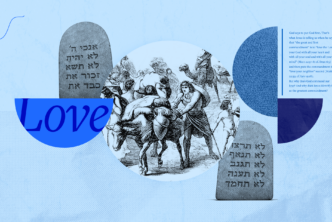The discipline of biblical theology represents an effort to describe the major themes and concerns of biblical authors at a level beyond a single text. In a sense, it is exegetical theology. We are giving the ancient authors “voice” about the topics of greatest concern to them, to hear them, in so far as it is possible, as they were heard in their world, and within the context of their literary creations.
When I wrote my book, Shepherds after My Own Heart: Pastoral Traditions and Leadership in the Bible, I treated the topic as a sequence of conversations. Imagine sitting with Ezekiel and trying to understand why he used the image of shepherd to describe good and bad leadership. In the course of the conversation we come to appreciate his historical setting and the people to whom he wrote. Naturally we take into consideration the overall structure of his book and where, how and why the particular issue of leadership comes to its surface.
Other voices
The presence of other “voices” complicates the conversation. Ezekiel reflects upon the ancient wilderness traditions of Moses and the royal traditions of David, but also upon the more recent prophetic indictments of Jeremiah. Listening to Ezekiel means listening through him (or with him) to these other voices. Ezekiel will in turn be quoted by later biblical writers who utilize his contributions to shepherd leadership for their own literary and theological purposes. Biblical theology places a premium on the discernible tone and texture of each of these individual voices. We discover a choral masterpiece, with common themes that are sung throughout at different times, in disparate ways, by numerous participants. The trained ear will recognize the theme whenever it appears, but will also discern the individuality and contribution of each voice.
Authors in their settings
Biblical theology engages an interest both in the individual emphases of various authors in their own settings, and in the common themes or traditions that course through the Scriptures. In our case, we are tracing the development of a tradition—an evolving canonical conversation—about the topic of shepherd leadership. Any theme in the Bible will naturally interact with others. The challenge in a study like this is to contain the investigation. In one source, for example, shepherd imagery is embedded in royal traditions. In another it is attached to second exodus traditions. In the Gospels it may play a role in presenting Jesus as a new Moses, a new David, or both. It is important to ask why each author used the shepherd image and how it was related to these traditions, but we will constantly negotiate how much space to give to the answers. While this may create some frustration, to treat our topic as though it were unrelated to these others would do injustice to the developing conversation.
Rivers and streams
Imagine the great themes of the Bible as rivers, many of which begin in the lofty heights of the Pentateuch. A particular river sometimes comes into full view as rushing rapids. At other times it moves in secret through subterranean passages. Wherever the water flows there is movement and sound, but at the more remote depths it requires keener powers of observation and better tools to locate it. The evidence of a given river at regular intervals “above ground” makes the discovery of the intervening segments below more likely. The thesis of this present work is that a discernible pastoral “stream of tradition” flows through Scripture. This tradition provides a broader context for understanding the nature of leaders in the covenant community, and for understanding the nature of that community as the flock of the divine Shepherd.
Most of the Bible’s pastoral imagery is embedded in two traditions. These might be thought of as the springs or fountainheads of the watercourses we will trace. The first is the exodus/wilderness complex. Looking back on this time in Israel’s history, inspired writers saw YHWH revealing himself as protector, provider and guide, the ultimate Shepherd of his flock. In this setting Moses functioned as God’s undershepherd. When Israel subsequently requests a king, another major tradition emerges that is associated with the shepherd king David and his dynasty. Many messianic promises are situated in this latter stream. These two traditions provide prototypes for the leaders who follow. Moses and David are prototypical leaders. More importantly, YHWH reveals himself as the true Shepherd Ruler of Israel.
After investigating these two springs, I sought to follow the river where it leads. Four prophets in the Old Testament make sustained use of pastoral imagery: Isaiah, Jeremiah, Ezekiel and Zechariah. Each in his own way recalls the exodus and/or wilderness. Each reflects on the Davidic covenant, emphasizing pastoral motifs in the process. In turn, each propels the river forward, adding new energy and dimensions to the images, creating expectation for a second exodus and a unique shepherd king.
A careful reader follows the river through the four Gospels, again a mix of ancient deposits with new emphases and revelations. Each in their own way, the Gospels depict a shepherd who has come to lead God’s flock in the promised new kingdom. Mark focuses on the shepherd of the second exodus. Matthew reveals the compassionate Davidic shepherd. Luke presents the seeking and saving shepherd. John describes the self-sacrificing shepherd.
In light of this, I consider the reflections of Peter in his first epistle and of John in the book of Revelation. Although one might have assumed that this “pastoral theology” would lead us to the “pastoral epistles,” it takes us, instead, to these eschatological letters that emphasize the marginalization of the community. In these two books Christians are understood still to be in exile. Here leaders are challenged to follow the divine Shepherd who became their sacrificial lamb. In Revelation it becomes clear that following the Shepherd Lamb entails dying for him.
Weighing the testaments
My investigation in Shepherds after My Own Heart is balanced in some intentional ways. It gives proportionate weight to both Testaments as it searches for continuity among these themes. What is foundational is valued, as well as what is cumulative. My approach also balances interest in both cultural background and literary context. Research on shepherd passages has often been focused exclusively on pastoral realities or on textual traditions (including extrabiblical parallels). Good biblical theology, like good exegesis, respects context—Old and New, cultural and literary—when attempting to discern meaning.
This article is lightly adapted from Timothy S. Laniak, Shepherds after My Own Heart: Pastoral Traditions and Leadership in the Bible, ed. D. A. Carson, vol. 20, New Studies in Biblical Theology (Nottingham, England; Downers Grove, IL: InterVarsity Press; Apollos, 2006), 23–26







